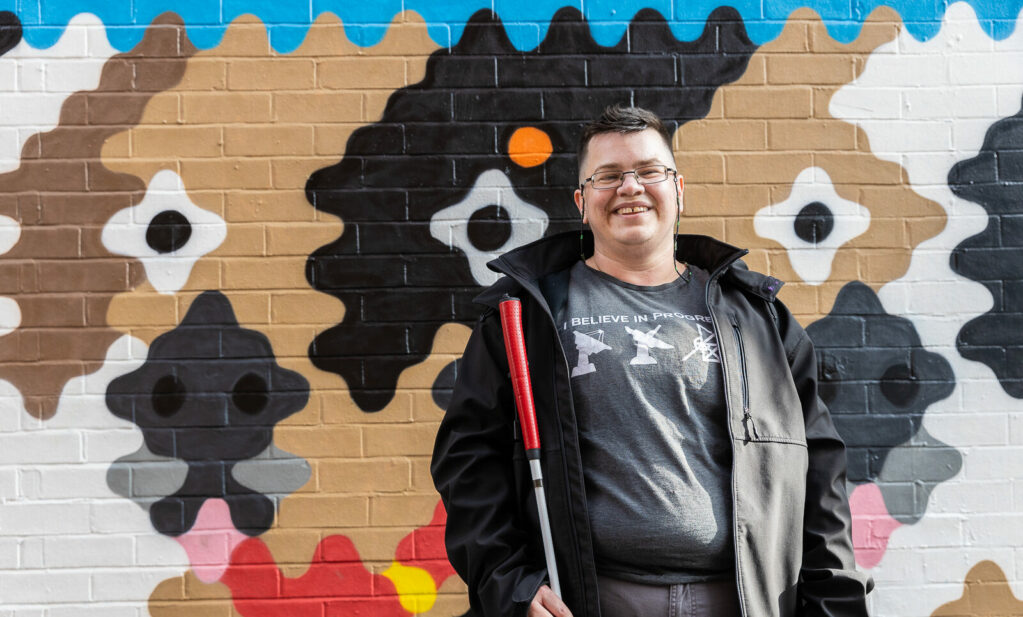Pros and Cons about the new Elizabeth Line (Crossrail) trains
Transport for All
In January, Transport for All (TfA) members were invited by Transport for London (TfL) to visit the new Elizabeth Line...
In January, Transport for All (TfA) members were invited by Transport for London (TfL) to visit the new Elizabeth Line (formerly called Crossrail) trains. We were quite impressed by their design.
Mohammed Mohsanali who has a visual impairment and Gwynneth Pedler who use an electric wheelchair travelled together to Derby where 66 new trains are being designed and built at Bombardier. They went with representatives from Guide Dog and TfL, including Paul Marchant, Product Design Manager who works in the Marketing Services – Design team who designed the interior of the new trains.
During the day, TfL gave us more details about their plans in term of accessibility at stations and on-board. We also had the opportunity to board a carriage giving us a better idea of what the access features (e.g. wheelchair priority space) will be.
Here’s our list of Pros and Cons regarding the new Elizabeth Line trains and stations.
Pros
Gwynneth and Mohammed were very impressed by the design of the new Elizabeth Line.
Inside the carriages:
The carriage we visited seemed spacious and wider than on the Tube – maybe not as wide as in Overground trains. Trains are composed of nine walk-through carriages stretching to over 200 metres long, with capacity for 1500 customers. Each carriage will have three wide doorways, with clear areas around the doors, to enable people to get on and off quickly. In the central stations, there will be entrances to the platforms at both ends. In the outer stations the entrances will be at various locations.
Here are the accessible features we tested or have been mentioned:
- Each train will have four designated spaces for wheelchair users, which Gwynneth found easy to access. The dedicated wheelchair spaces will be located in the centre of the train. Additionally there will be ten multi-use spaces for luggage, buggies and bicycles.
- There will be a mixture of metro and bay seating throughout the train. Priority seats will be identified with blue stickers and different upholstery. We haven’t seen them yet.
- We saw the facilities in place to alert and speak to the driver in the event of an emergency.
- Finally, each carriage is equipped with information screens and an audio system to deliver real time travel information allowing customers to plan their onward journeys while on-board.
At the stations:
The first positive things regarding the station is of course the fact that, following the intense campaign from Transport for All, all the stations will be fully accessible from day 1. Twelve stations will have step-free access from the street to the train and 28 will have step-free access from the street to the platforms with access to the trains made via a manual boarding ramp.
Transport for London confirmed that the following access features will be available at the stations:
- Hearing loops at ticket office windows
- Wide Access Gates
- Help Points on every platform
- Platform edge doors in the central stations
- Staff at every station from first to last train
Cons
We haven’t seen many negative aspects to the design yet. The only thing that we found disappointing is the fact that TfL didn’t hear our requests to include toilets on-board. Concerns about finding usable toilets are the source of a great deal of stress and anxiety for older and Disabled people when they travel. The longest journey on the Elizabeth line could last around 45-50minutes. But TfL explained that “it is estimated that the average time a passenger will travel on the new line will be around 20 minutes”. Also 33 out of the 40 Elizabeth line stations will have toilet and accessible toilet facilities, with a further five stations having toilet provision in an adjacent building. Compared to the rest of the Network this is a major improvement even if it’s not perfect yet.
Another negative point is the fact that the grab poles are black and silver making it very difficult for people with visual impairments to see them. This choice has been made despite the regular calls from TfA members to TfL representatives to use brighter colours. This is a major step backward.
Otherwise, it will all depend on the way plans will be effectively implemented. We haven’t yet seen the signage that will be used on carriages and it would be interesting to visit the trains once those have been placed. We need large and bright signage.


